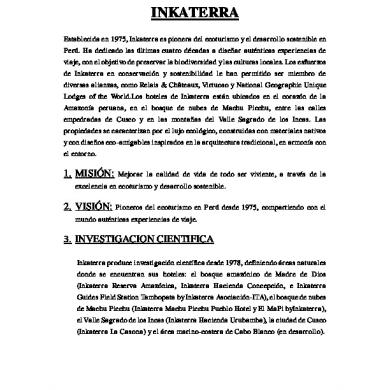Physics Pressure
This document was uploaded by user and they confirmed that they have the permission to share it. If you are author or own the copyright of this book, please report to us by using this DMCA report form. Report DMCA
Overview
Download & View Physics Pressure as PDF for free.
More details
- Words: 490
- Pages: 2
Worded content on the PowerPoint on Centripetal Force By Army Seals Introduction Centripetal Force What is it? It is a force which acts on a body moving in a circular path and is directed towards the centre around which the body is moving. A diagram of centripetal force Centrifugal Vs Centripetal A labelled diagram depicting the difference of the two. Centrifugal Force This is the reacting force that makes objects move outwards when they are spinning around something or travelling in a curve. A diagram of centrifugal force Calculating Centripetal Force Fc=mv2/r and what each part of the formula was illustrated in a picture What are Examples? Pictures of a car turn a corner at high speed, children on a round around, and a man swinging a ball in circles using a rope. What is efficiency? This is the state of achieving maximum productivity with minimum wasted effort or expense. Efficiency of Machines This is the work done by a machine which is expressed in a ratio between the input and output effort, measured in percentage. How to calculate it? To calculate the efficiency of a machine, divide the output work by the input work and multiply the result by 100 percent. A picture of the formula was displayed. An example was given. Mechanical Advantage This is a measurement of the force amplification achieved by using a tool, mechanical device or machine system. In other words, it is the ratio of the output force (load) of a machine to the input force (effort). An example was given. Velocity Ratio
This is the ratio of the distance moved by the point at which the effort is applied, in a machine, to the distance moved by the point at which the load is applied, in the same time. It is also called the distance ratio. A picture of the formula was displayed Worded part of the examples Incline Planes VR = Displacement moved by effort/Displacement by load =10m/2m =5 Single Fixed Pulley VR = Displacement moved by effort /Displacement by load = 10m/ 10m =1 Note: Although the work wasn’t made easier, it is convenient as the force is inverted. Single Movable Pulley VR = Displacement moved by effort /Displacement by load = (5m + 5m)/ 5m =10m/5m =2 Block and Tackle
VR = Displacement moved by effort /Displacement by load = 30m / 10m =3 Slowing Gears VR = Displacement moved by effort /Displacement by load = 1rev.(25/25teeth) / 1/3rev. (25/75teeth) =1: (1/3) =0.333
Therefore, it would take 3 rev. of the smaller gear to turn 1 rev. of the larger gear, slowing down the machine. Speeding Gears VR = Displacement moved by effort /Displacement by load = 1rev.(40/40teeth) / 2rev. (40/20teeth) =1:2 =0.5 Therefore, it would take 1/2 rev. of the larger gear to turn 1 rev. of the smaller gear, speeding up the machine. Hydraulic lift VR = Displacement moved by effort /Displacement by load = 100m/50m =2:1 =2
This is the ratio of the distance moved by the point at which the effort is applied, in a machine, to the distance moved by the point at which the load is applied, in the same time. It is also called the distance ratio. A picture of the formula was displayed Worded part of the examples Incline Planes VR = Displacement moved by effort/Displacement by load =10m/2m =5 Single Fixed Pulley VR = Displacement moved by effort /Displacement by load = 10m/ 10m =1 Note: Although the work wasn’t made easier, it is convenient as the force is inverted. Single Movable Pulley VR = Displacement moved by effort /Displacement by load = (5m + 5m)/ 5m =10m/5m =2 Block and Tackle
VR = Displacement moved by effort /Displacement by load = 30m / 10m =3 Slowing Gears VR = Displacement moved by effort /Displacement by load = 1rev.(25/25teeth) / 1/3rev. (25/75teeth) =1: (1/3) =0.333
Therefore, it would take 3 rev. of the smaller gear to turn 1 rev. of the larger gear, slowing down the machine. Speeding Gears VR = Displacement moved by effort /Displacement by load = 1rev.(40/40teeth) / 2rev. (40/20teeth) =1:2 =0.5 Therefore, it would take 1/2 rev. of the larger gear to turn 1 rev. of the smaller gear, speeding up the machine. Hydraulic lift VR = Displacement moved by effort /Displacement by load = 100m/50m =2:1 =2
Related Documents

Physics Pressure
August 2019 35
Pressure
May 2020 25
Pressure
November 2019 31
Pressure
May 2020 23
Physics Buoyancy And Pressure: Study Problems
December 2019 21
Test Physics (force And Pressure + Heat)
May 2020 12More Documents from "Hafizul Hanis"

English Summary Home Work.docx
August 2019 19
Maths Sba Test Paras.docx
November 2019 14
Physics Pressure
August 2019 35
Englisb Report To Do List.txt
November 2019 24
Aqua Aerobics Passage Summary.docx
August 2019 17